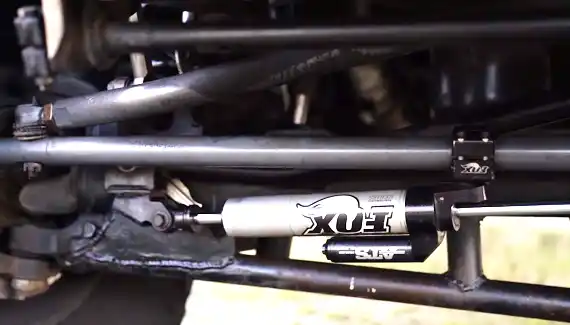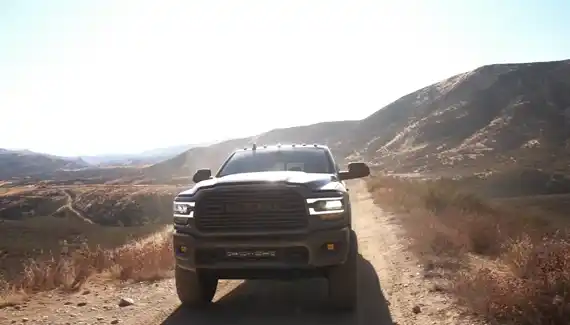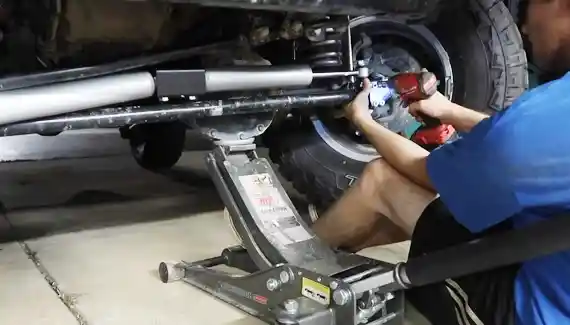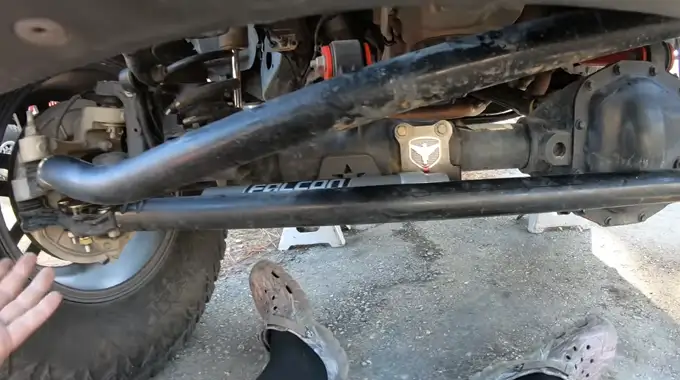Last Updated on March 19, 2023
Installing a lift kit on your vehicle can lead to numerous advantages and potential problems. One of these issues is bump steer or death wobble, which can be caused when the suspension geometry of your lifted vehicle is changed.
Fortunately, installing a steering stabilizer can help you improve control and stability while driving your lifted vehicle. A steering stabilizer can also reduce the amount of strain on your steering components, helping them to last longer. It also increases control and comfort when driving over uneven terrain or at high speeds.
Today, we will discuss what a steering stabilizer does, how it works with a lift kit, and why it is an important component of any lifted vehicle. Find out what you need to know about steering stabilizers and lift kits to make an informed decision about your vehicle’s setup.
Why Do You Need a Steering Stabilizer With a Lift Kit: Reasons

A steering stabilizer with a lift kit is essential to ensure strong and safe driving. Driving with a lift kit can be an incredibly exhilarating experience, but it can also come with problems. Steering stabilizers can solve these issues and keep your ride comfortable and controlled no matter how far you go.
The following are some significant reasons to have a steering stabilizer along with a lift kit:
Improved Steering Control
A lift kit will raise the overall height of your vehicle, providing more ground clearance for off-road adventures. Unfortunately, this also increases the angle at which the tie rod must operate, reducing steering control due to increased drag on the system.
Adding a steering stabilizer helps reduce this drag by increasing hydraulic pressure in the system and increasing dampening power. This allows for smoother and more precise turns while reducing the required effort.
Reduce Steering Vibration
The increased drag associated with a lift kit can lead to increased steering wheel vibration and discomfort over uneven terrain. A quality steering stabilizer can help reduce this vibration by absorbing some shock before it reaches the driver’s hands.
By decreasing the amplitude of vibrations caused by road conditions or other factors, drivers can enjoy enhanced comfort and stability during their journey.
Protection for Suspension Components
Adding extra weight to suspension components can cause premature wear and tear if not taken care of. The extra stress created by higher angles also places extra strain on other parts of your vehicle, such as u-joints and ball joints, which may need replacing over time without protection from a stabilizer bar or shock absorber setup.
A good quality steering stabilizer will absorb some of this added strain and help protect your suspension components from unnecessary damage over time.
Increased Tire Wear
When you have a lift kit installed on your vehicle, the added height increases the distance between the tires and the road surface, which can cause more strain on the tires.
Having a steering stabilizer attached to a lift kit reduces some of that strain by decreasing the amount of movement in the suspension. This prevents premature tire wear and helps keep your tires from unevenly wearing out due to excessive flexing or bouncing.
Better Driving Performance

Improved driving performance can be a great asset for any vehicle, and adding a steering stabilizer with a lift kit can help you get the most out of your ride. This setup boosts stability by reducing body roll in turns and during quick acceleration/braking, giving you a firmer grip on the road.
Not only does this enhance safety and comfort, but it also gives you better control when taking even those sharpest of corners or tackling tricky surfaces. So, consider investing in a steering stabilizer and lift kit to take your driving performance to the next level.
Prevent Death Wobble Accidents
The “death wobble” is an unwanted side effect of having super duty suspension components like sway bars or aftermarket lift kits installed on your truck or SUV that causes violent vibration in the steering wheel when going over bumps at high speeds.
If not properly taken care of, this can lead to catastrophic consequences such as loss of control or an accident if your steering wheel gets locked up due to excessive vibrations from these components being too stiff.
Installing a steering stabilizer alongside a lift kit helps reduce this issue by dampening any excess vibration before it reaches your hands so you won’t experience sudden jolts or jerks that could throw off your balance while driving.
What Does a Steering Stabilizer Do on a Lifted Vehicle?
A steering stabilizer, AKA a steering damper, works by dampening the side-to-side motion of the tires, providing improved handling and ride comfort. Reduced suspension vibration helps reduce driver fatigue and improves vehicle handling. This is especially beneficial for large vehicles with off-road capabilities.
On a lifted vehicle, installing a steering stabilizer is essential for increased safety. The extra weight from the lift kit can cause more instability in the steering and suspension system causing it to react more quickly when turning or taking sharp corners.
How Does a Steering Stabilizer Work With a Lift Kit?

When a lift kit is installed, it can increase suspension travel and make bumpy roads more difficult to navigate. The steering stabilizer uses a hydraulic piston to absorb and dissipate some of this energy created when the front wheels encounter bumps or irregularities in the road surface.
This process reduces the vibration inside the vehicle and makes driving easier on rough terrain. Also, a lift kit with a steering stabilizer can help minimize body roll by allowing for better control over larger bumps. Steering stabilizers make a huge difference in lift kit installation by reducing vibration and improving handling.
What Causes Death Wobble in Lifted Trucks?
Death wobble is a frightening phenomenon that occurs when the steering of a lifted truck begins to shake uncontrollably. It is caused by improper installation, damage, looseness, or missing parts in the suspension and/or steering components. This can be hard to diagnose, so treating it immediately before serious damage happens is best.
When a truck is lifted, it stresses all the parts underneath, including the steering and suspension components. During the lifting process, if anything isn’t installed properly, it could cause misalignments or strain on the suspension or steering. When this happens, the steering wheel can vibrate, resulting in a death wobble.
Other causes include worn-out tie rod ends, damaged sway bars or arms bushings, weak shock absorbers or struts, unevenly aligned tires and wheels, and incorrect toe alignment settings. Any of these issues can put extra pressure on other components, creating an imbalance that leads to death wobble.
Owners of lifted trucks need to have their vehicles regularly inspected for any problems relating to their suspension or steering systems. As soon as any issues are noted, they should be addressed as soon as possible to avoid a potential death wobble situation while driving.
Do Steering Stabilizers Prevent Lifted Car Speed Death Wobble?
Steering stabilizers can help to stop lifted car speed death wobble in certain circumstances. These stabilizers are a great solution for mitigating the effects of lifted car speed death wobble.
When correctly mounted, they can absorb forces created by oscillations and minimize wheel vibrations. This helps ensure that vehicle components and systems stay in top condition while creating a smoother ride experience at higher speeds.
What’s Better: Single or Dual Steering Stabilizer Kit for a Lifted Vehicle?

Choosing a steering stabilizer can be challenging when it comes to lifted vehicles. The main factor in determining the best option for your vehicle is how often you plan on using it and how much wear and tear it will take.
A single steering stabilizer should suffice if you plan on using your vehicle for daily driving. This is because single-steering stabilizers provide more control than dual-steering stabilizers, making them ideal for everyday use.
On the other hand, a dual steering stabilizer may be more beneficial if you plan to do heavy off-roading or add heavier accessories such as snow plows. Dual steering stabilizers have extra dampening power, which helps to reduce any excess vibration caused by heavy terrain or load-bearing items attached to the vehicle.
Also, dual steering stabilizers reduce slop and “feedback” from the front wheels when turning corners under high loads, allowing for better maneuverability when traversing tough terrain or carrying heavy items.
How Many Miles Does a Steering Stabilizer Last With a Lift Kit?
Generally, a steering stabilizer can last between 50,000 to 100,000 miles of life to a vehicle with a lift kit. But the number of miles will ultimately depend on several factors, such as terrain and road conditions.
If you are driving on rough or uneven roads or through areas with deep potholes, snowdrifts, or other obstacles, your stabilizer may wear out sooner than expected. Other factors that can affect its lifespan include the type and quality of the product used, frequency of use, and maintenance schedule.
It is also important to note that installing a steering stabilizer does not necessarily guarantee increased longevity. It simply helps maintain an acceptable level of performance while riding on rugged terrain and improve overall handling characteristics.
Get Greater Control & Comfort: Invest in a Steering Stabilizer for Lifted Vehicle
Steering stabilizers are essential to any lifted vehicle. It helps reduce wobbling, gives you better control and stability while driving, and increases comfort over uneven terrain and at higher speeds.
Investing in the right steering stabilizers will ensure your car runs smoother without losing its balance or performance capabilities. Also, having one has other benefits, such as improved handling and smoother cornering.
Because of all these benefits, it’s no wonder people pick steering stabilizers with lift kits. No matter what kind of lifted vehicle you have, SUV, truck, or other lifted vehicles, make sure you have steering stabilizers for better safety and performance.
